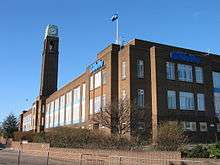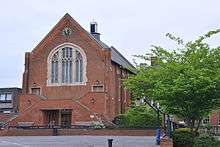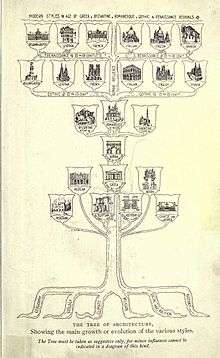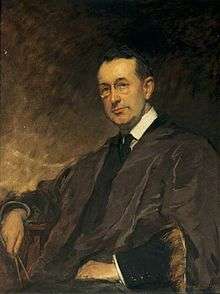Banister Fletcher (junior)
%2C_PRIBA%2C_FSA%3B_The_Royal_Institute_of_British_Architects.jpg)
Sir Banister Flight Fletcher (15 February 1866, London – 17 August 1953, London) was an English architect and architectural historian, as was his father, also named Banister Fletcher. They wrote the standard textbook A History of Architecture, which is also often referred to just as Banister Fletcher.
Life

Fletcher trained at King's College London and University College, London, and joined his father's practice in 1884, also studying at the Royal Academy Schools, the Architectural Association, and the École des Beaux-Arts, Paris. He became a partner in 1889, and on his father's death in 1899 took over the practice, which continued to be called Banister Fletcher & Sons. Fletcher worked closely with his younger brother Herbert Phillips Fletcher (1872–1916) as well as his father. Herbert was also a partner in the family firm and they wrote some books together. He was "regarded as a minor figure in the modernist movement" in his early career, and generally preferred to write rather than design.[1]

Banister's work as an architect included:
- the Gillette factory on the Great West Road, in Brentford, Middlesex
- John Roan School (Maze Hill site), Greenwich[2]
- the Great Hall at King's College School[3]
- Abbess Grange, Leckford, Hampshire
In 1908 he qualified as a barrister at the Inner Temple, and undertook arbitrations and advice on property matters.[4]
He was knighted in 1919 and elected president of the Royal Institute of British Architects (RIBA) in 1929 (until 1931). Fletcher was surveyor to the Worshipful Company of Carpenters, and became Master in 1936, a position also held by his father.
He married twice, first, in 1914, to Alice Bretherton (d.1932)[5] and again in 1933. He had no children.[6]
A History of Architecture
%2C_PRIBA%3B_The_Royal_Institute_of_British_Architects.jpg)
He and his father wrote the first edition of A History of Architecture on the Comparative Method.[7][8] This became a standard reference work, with updated editions published throughout the 20th century.
There was a major revision with the 6th edition in 1921, when much of the text was rewritten by Fletcher and his first wife. This was over twenty years after his father’s death, and for this edition his father’s name was dropped, and the very numerous drawings replaced by new ones by George G. Woodward and others.[9] According to J. Mordaunt Crook this edition concentrated 'on supplying an epitomised history of world architecture' such that 'Fletcher turned a useful handbook into a veritable student's bible.' Fletcher produced the sixteenth edition shortly before his death in 1953.[10]
A centenary 20th edition edited by Dan Cruickshank was produced in 1996.[11]
- "A thundering classic appears again with useful additions. As Sir Banister Fletcher said, 'The study of architecture opens up the enjoyment of buildings with an appreciation of their purpose, meaning, and charm.' These words aptly summarise what this book has become for generations of students and architects. No serious fan of architecture should be without it." (American Institute of Architects).
- "..the whole point of Banister Fletcher is that it does cram everything into a single volume. It will remain one of the most thumbed tomes in Building Design's office library...above all, gloriously and frustratingly, invaluable." (Building Design, October 1996)
The Tree of Architecture

Banister Fletcher's "The Tree of Architecture" is a schematic diagram detailing what Fletcher identified as the "branches" of architectural style beginning with five periods (Peruvian, Egyptian, Greek, Assyrian, and Chinese and Japanese) and culminating in the Modern American style. Initially published as a frontispiece in the first edition of Fletcher's A History of Architecture on the Comparative Method for the Student, Craftsman, and Amateur in 1896, the schematic was reproduced in each subsequent edition of the publication. Fletcher suggests a cross-cultural and historical evolution of architectural styles through a series of successive branches, some of which terminate prior to the Modern period including Mexican and Indian, while other lineages can be traced through multiple generations into the final apex of Modern style. Recent scholarship has been critical of Fletcher's hierarchical emphasis on the primacy of Western European architectural traditions.[12]
Legacy

- In his will, he left a bequest to the Bartlett School of Architecture inaugurating an annual prize, the Sir Banister Fletcher Prize and Medal, in memory of his father, brother and himself.[13]
- In his will, he left a bequest to the London Society to hold an annual lecture in his name.[14]
- The Authors' Club, of which Fletcher was president, presents an annual Banister Fletcher Award for the best book on art or architecture.[15]
Selected other works
- Fletcher, Banister, Recent development of early renaissance in England, London : C.W. Sweet, 1894
- Andrea Palladio (1902), which was not well received by critics.[16]
- Fletcher, Banister ; Fletcher, Sir Banister; Fletcher, Herbert Phillips, Arbitrations: a text-book for arbitrators, umpires & all connected with arbitrations, more especially architects, engineers and surveyors in tabulated form, with the chief cases governing the same, and an appendix of forms, statutes, rules, etc., London : B.T. Batsford, 1904
- Architectural Works (1934) with William Hanneford-Smith
Notes
- ↑ ODNB
- ↑ The John Roan School (upper School), Greenwich http://www.britishlistedbuildings.co.uk/en-504217-the-john-roan-school-upper-school-greenw
- ↑
- Map and pictures of King's College School Archived 3 February 2012 at the Wayback Machine.
- ↑ ODNB
- ↑ "Alice Maud Mary (nee Bretherton), Lady Fletcher". National Portrait Gallery.
- ↑ ODNB
- ↑ A History of Architecture on the Comparative Method. London: Athlone Press, University of London, 1896– [issued serially], first single-volume edition, London: B.T. Batsford and New York: C. Scribner's Sons, 1896
- ↑ A history of architecture on the comparative method (1905) Fletcher, Banister, 1833–1899; AND Fletcher, Banister, Sir, 1866–1953 Publisher: London : Batsford NOT_IN_COPYRIGHT https://archive.org/details/historyofarchite00fletuoft
- ↑ ODNB
- ↑ http://www.audacity.org/downloads/JMcK-04-Pillar-to-Post.pdf and http://eprints.brighton.ac.uk/2808/
- ↑ Cruickshank, Dan (editor), Banister Fletcher's A History of Architecture], Architectural Press, 20th edition, 1996. ISBN 0-7506-2267-9
- ↑ Barry, Flood (2007). "From the Prophet to Modernism? New World Orders and the End of Islamic Art". In Mansfield, Elizabeth. Making Art History: A Changing Discipline and its Institutions. New York: Routledge. p. 31.
- ↑ http://www.ucl.ac.uk/current-students/money/scholarships/built-environment/banister-fletcher
- ↑ Annual Banister Fletcher Lecture of the London Society, 15 December 2010 – http://www.londonsocietyjournal.org.uk/461/davidgilbert.php
- ↑ "Archived copy". Archived from the original on 9 March 2012. Retrieved 2012-01-26.
- ↑ ODNB
References
- "ODNB": H. V. M. Roberts, 'Fletcher, Sir Banister Flight (1866–1953)', rev. Catherine Gordon, Oxford Dictionary of National Biography, Oxford University Press, 2004 accessed 16 May 2012
Further reading
- McKean, John (2009) "Sir Banister Fletcher: Pillar to Post-Colonial Readings", The Journal of Architecture, 11 (2). pp. 187–204. ISSN 1466-4410
- Rabbat, Nasser (2012) "Islamic Art at a Crossroads?," in Ed. Junod, Benoit; Kahlil, Georges; Weber, Stefan; and Wolf, Gerhard; Islamic Art and the Museum: Approaches to the Art and Archaeology of the Muslim World in the Twenty-First Century (London: Saqi Books, 2012), 79-80.
External links
![]()